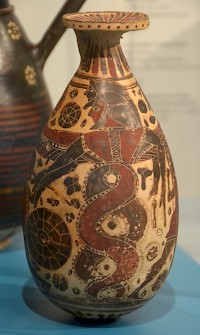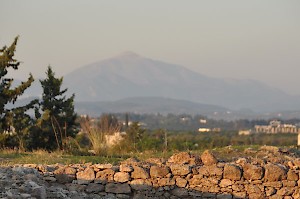Typhon
Typhon (Greek Τυφῶν): in Greek mythology a giant monster, opponent of the supreme god Zeus and the Olympian gods.

The first description of Typhon can be found in Hesiod’s Theogony:note a child of Gaia and Tartarus (Mother Earth and the Underworld), he has the body of a snake with a hundred heads, is extremely strong, produces the sounds of all animals, and spits fire. However, the supreme god Zeus recognizes the threat and fights a duel on the beach, defeating the many-headed monster with his thunderbolts. Typhon is cast down in the Underworld, from where he blows all kinds of winds to the surface of the world.
We also learn that Typhon had intercourse with another snake-like monster, Echidna, who gives birth to the nine-headed snake Hydra, the three-headed dog Cerberus, and the fire-blowing Chimaera.note
The Third Homeric Hymn, composed in the sixth century BCE and dedicated to Apollo of Delphi, tells a similar story, although this time it is Hera and not Gaia who is Typhon’s mother. The monster has no father and is educated by Pytho, the dragon of Delphi.note
Several Greek stories place the birth of Typhon in the east, in Cilicia. A later myth, recorded by Apollodorus,note is that the Olympian deities were very scared of Typhon and fled to Egypt, where they dressed up like animals. This story is meant to explain why the Egyptian gods looked like falcons, cows, and so on. Finally, Zeus cast Typhon into the Underworld, from where he still spits fire: the Etna.
This is not the first Egyptian connection. Herodotus already identified Typhon with the Egyptian god Seth,note and in his Isis and Osiris, Plutarch made the same identification.note The magic papyri refer to Typhon-Seth too.

The Greek story has roots in the Near East, where several ancient myths were told about a supreme god defeating a terrible monster. In Enuma Eliš, the Babylonian epic of creation, Marduk (a storm god employing thunderbolts like Zeus) successfully fights a duel with an aquatic monster named Tiamat, while the other deities are very afraid. A myth from Ugarit tells how Baal defeats Yam, a personification of the sea, near Mount Saphon (also known as Mount Casius).
Finally, it must be noted that Strabo records an Aramaean tradition that the river Orontes used to be called after Typhon, who had once been struck by a bolt of lightning and had fled underground, cutting the earth, forming the bed of the river, and finally causing the fountain to break forth to the surface.note All these stories were orally transmitted.
The mythology and iconography has influenced Jewish and Christian ideas about the struggle between good and evil.